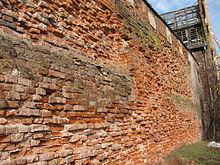Castles in Gdansk
There were castles in Gdansk from the 9th century to 1454.
Castle on the Hagelsberg
location
The castle was located on the Hagelsberg ( Góra Gradkowa ) east of the later old town . From there a tributary led to the Motlau , which then flowed into the Vistula .
history
The castle existed since the 9th century at the latest. It belonged to the sphere of influence of the Scandinavian Normans in their network of roads on the Baltic Sea. An important trade route led through the Vistula via the Dniester into the Black Sea and the Byzantine Empire.
There are hardly any archaeological findings on the mountain as a fortress was built there in the 17th century. The earliest finds are Arabic coins from the early 9th century on the Hagelsberg and at its foot. At the castle there was a settlement on the later Nikolaikirche , where there had been a cemetery and probably a church since the 10th century, and in the area of the later town hall .
In the late 10th century, the area came under the control of the Polish dukes. The castle is only mentioned in 997, when the missionary Adalbert of Prague came to the urbs Gyddanyzc with the permission of Duke Bolesław Chrobry and found that there were already Christians there.
Castle of the Dukes of Gdansk
location
The castle was located directly on the bank of the Motława just before its confluence with the Vistula west of the old town. It was on an island (according to hydrographic findings) and was about 0.4 hectares in size. To the northwest, there was a settlement in which mainly Kashubian and Prussian fishermen, craftsmen and merchants lived.
history
Around 1050, under Polish rule, a new castle was founded directly on the Motława, which was more conveniently located near the Vistula. It was initially the seat of a governor in Danzig.
From 1148 the oldest mention is received as castrum Kdancz in Pomerania , which was in the spiritual jurisdiction of the diocese of Wroclaw . A church of the Theotokos ( [ecclesia] Sanctae dei genetricis Mariae ) was also mentioned. To the west of the castle, another settlement of mostly German merchants and craftsmen developed, some of whom came from Lübeck .
The area was then temporarily under Danish rule. After 1200 the governor Mestwin ( Mestui ) acquired an extensive area of dominion until what was later to become the Western Pomerania region and tried to break away from the Danish and Polish sovereignty. This was achieved by his son Swantopolk II, who had been an independent ruler in Danzig and the surrounding area ( Pomerania ) since 1227 . He gave the German merchants' settlement around the Katharinen- and Nikolaikirche city rights according to Luebian law (around 1227/1263).
Ordensburg Gdansk
Location and description
The order castle was located on the site of the previous Pomeranian ducal castle. The high castle was a massive square building with four mighty towers. The northeast tower was the tallest structure and no church tower was allowed to be towered over it. There were other buildings on the castle grounds. The complex was enclosed by mighty fortress walls. There was a gate to the Radaune (later the Rähmtor ).
Parts of a bastion that were built into a town house and remains of the external fortifications on the bank of the Motława River, both in ul. Wartka, have survived from the castle. The course of the path west of the order castle within the fortress walls has been preserved in the street Am Rähm .
history
In 1308 the Teutonic Order conquered Danzig. The new castle was built around 1340. It was the seat of a commander. During the time of the order, the settlements continued to develop, he granted city rights to the old town, the new town and a young town he founded. In addition to documents, some wax tablets were preserved from the legal activities of this time.
In 1454, Danzigers stormed the castle and destroyed it after the cities had submitted to the Polish king.
Further development
Rebuilding of the site was initially prohibited. Residential houses have been built there since 1648. Today the area forms the district of Zamczysko.
See also
literature
- Jerzy Kmieciński: Gdańsk - geneza średniowiecznego miasta i portu. [Gdansk, Development of the Medieval City and the Port], In: Zakład archeologiczny. No. 65. 2017. pp. 133–149, indicates the state of archaeological research, with 16 images (Polish, with English captions) PDF
Web links
- Beginnings of Gdansk Gedanopedia (Polish)
Individual evidence
- ↑ Kmieciński 2017, p. 39, with a plan of the settlements in the 10th century
- ↑ Life of St. Adalbert von Canaparius 998/999
- ↑ Kmieciński 2017, p. 37, illustration of the reconstruction representation
- ↑ Kmieciński 2017, p. 35, with an archaeologically reconstructed site plan
- ↑ Castle of the Gdańsk Commandery Audioguide Gdańsk (German)
- ↑ Zamczysko Gedanopedia (Polish)


